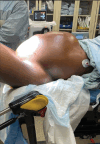Uterine Leiomyomata as a Cause of Abdominal Compartment Syndrome in the Postpartum Period
- PMID: 38370330
- PMCID: PMC10874694
- DOI: 10.1055/a-2164-8100
Uterine Leiomyomata as a Cause of Abdominal Compartment Syndrome in the Postpartum Period
Abstract
Uterine leiomyomas are common benign smooth muscle tumors that often occur during the reproductive years. Although many cases may not result in significant complications, negative pregnancy outcomes have been associated with the size and location of the fibroids. Degeneration of fibroids can occur as early as the late first trimester when they undergo significant volumetric growth, contributing to pain during pregnancy. While myomectomy is typically avoided during pregnancy, conservative management with anti-inflammatory medications may be effective. Surgical removal or preterm delivery may be necessary if symptoms persist. Abdominal compartment syndrome (ACS) is a rare condition characterized by sustained elevated intra-abdominal pressure leading to organ failure. Although ACS resulting from large-volume leiomyomas in the postpartum period has not been previously described, we present a case of a 25-year-old patient with massive uterine fibroids who required indicated preterm delivery via primary cesarean section at 25 weeks gestation. Her postpartum course was complicated by ACS, requiring emergent surgical decompression. When a large fibroid burden is present during pregnancy or in the postpartum period, ACS should be considered in the differential diagnosis. Early diagnosis and timely surgical decompression are necessary to prevent organ dysfunction and worsening maternal outcomes.
Keywords: abdominal compartment syndrome; postpartum; pregnancy; surgical decompression; uterine leiomyoma.
The Author(s). This is an open access article published by Thieme under the terms of the Creative Commons Attribution-NonDerivative-NonCommercial License, permitting copying and reproduction so long as the original work is given appropriate credit. Contents may not be used for commercial purposes, or adapted, remixed, transformed or built upon. ( https://creativecommons.org/licenses/by-nc-nd/4.0/ ).
Conflict of interest statement
Conflict of Interest None declared.
Figures




References
-
- Klatsky P C, Tran N D, Caughey A B, Fujimoto V Y. Fibroids and reproductive outcomes: a systematic literature review from conception to delivery. Am J Obstet Gynecol. 2008;198(04):357–366. - PubMed
-
- Katz V L, Dotters D J, Droegemeuller W. Complications of uterine leiomyomas in pregnancy. Obstet Gynecol. 1989;73(04):593–596. - PubMed
-
- Febo G, Tessarolo M, Leo L, Arduino S, Wierdis T, Lanza L. Surgical management of leiomyomata in pregnancy. Clin Exp Obstet Gynecol. 1997;24(02):76–78. - PubMed
-
- De Carolis S, Fatigante G, Ferrazzani S et al.Uterine myomectomy in pregnant women. Fetal Diagn Ther. 2001;16(02):116–119. - PubMed
Publication types
LinkOut - more resources
Full Text Sources

